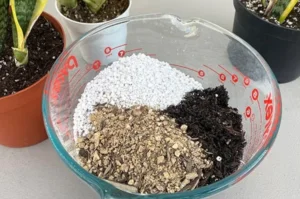Do you want to grow your snake plant bigger, stronger, and more vibrant than ever before? Repotting at the right time is the answer! This simple step can make a huge difference in your plant’s life, and I promise it’s easier than you think and extremely beneficial for your snake plant’s long-term health. Let’s explore why repotting is necessary for a snake plant.
Understanding Root-Bound Plants
Before diving into why repotting is necessary, let’s first understand what it means for a plant to be root-bound. When a plant outgrows its current pot, its roots become tightly packed, forming a dense mass at the bottom. This condition restricts the plant’s ability to absorb water and nutrients, hindering its growth.
What Does ‘Root-Bound’ Mean?
A root-bound plant occurs when the roots have filled the pot and have no more space to grow. In the case of snake plants, you may notice roots circling the bottom or poking out of the drainage holes. This indicates that the plant has outgrown its current container and needs to be repotted properly.
Why It’s a Problem
Root-bound plants face several challenges that can impact their health and growth. With limited space, the roots struggle to access water and nutrients from the soil. As a result, the plant may become stunted, and its foliage may start to wilt or turn yellow. Additionally, root-bound plants are more susceptible to root rot and other diseases due to poor drainage and airflow.
Signs Your Snake Plant Needs a New Home
Pay attention to these signs that your snake plant is ready to upgrade its living space:
- Visible Roots: See those roots poking through the drainage holes at the bottom? It’s the plant’s way of saying “Give me more space!”
- Cracked or Misshapen Pot: Powerful roots can sometimes break or misshapen their containers, especially plastic ones. Learn more about choosing the right pot to ensure your plant gets a suitable new home.
- Yellowing or Wilting: Foliage issues can signify several problems, but if your watering habits are good, it’s sometimes a sign of a crowded pot.
Benefits of Repotting a Snake Plant
Repotting your snake plant offers several benefits, including:
- Providing more space for root growth, allowing the plant to thrive.
- Refreshing the soil and replenishing nutrients, promoting healthier growth.
- Preventing root rot and other diseases by improving drainage and airflow.
- Enhancing the overall appearance of the plant, making it more attractive.
To ensure optimal soil conditions, check out this guide on the best soil for repotting.
When is the Ideal Time to Repot?
The best time to repot your snake plant is during the spring or early summer when it’s actively growing. Avoid repotting during the winter months when the plant is dormant, as it may cause unnecessary stress.
Repotting: Steps & Tips
Follow these steps to repot your snake plant successfully:
- Choose a slightly larger pot with drainage holes to allow excess water to escape.
- Prepare a well-draining potting mix suitable for succulents or cacti.
- Gently remove the plant from its current pot, being careful not to damage the roots.
- Loosen the roots and trim any dead or rotting parts with a clean knife.
- Place the plant in the new pot and fill it with fresh soil, leaving enough space for watering.
- Water the plant thoroughly and allow excess water to drain out of the bottom.
Frequently Asked Questions (FAQs):
Can I divide my snake plant during repotting?
Yes, you can divide mature snake plants by separating the rhizomes and planting them in individual pots.
What if my snake plant is too large to repot?
If your snake plant has become too large to repot, you can simply remove it from the pot, trim the roots, and replace the soil in the same container.
In conclusion, repotting is necessary to keep your snake plant vibrant and healthy. By providing more space for root growth and refreshing the soil, you can ensure that your plant continues to thrive for years to come. Don’t be afraid to repot when you see the signs, and make sure you follow the above instructions for a smooth transition. Your snake plant will thank you with vibrant foliage and continued growth!






